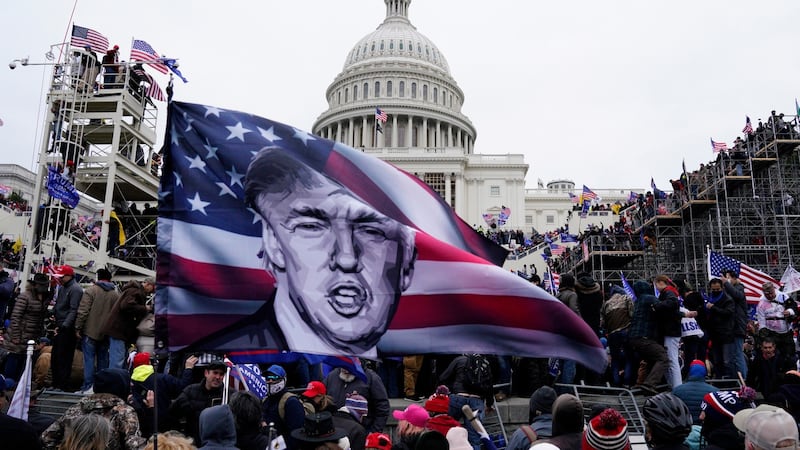In the summer of 2015, America caught a glimpse of how its future could unfold. The US military conducted a routine exercise in the south that triggered a cascade of conspiracy theories, particularly in Texas. Some believed the manoeuvre was the precursor to a Chinese invasion; others thought it would coincide with a massive asteroid strike. The exercise, called Jade Helm 15, stood for “homeland eradication of local militants”, according to one of the right’s dark fantasy sites. Greg Abbot, Texas’s Republican governor, took these ravings seriously. He ensured that the 1,200 federal troops were closely monitored by the armed Texas National Guard. In that bizarre episode, which took place a year before Donald Trump became the Republican nominee for president, we see the germs of an American break-up.
As with any warning of impending civil war, the very mention of another American one sounds impossibly alarmist – like persistent warnings from chief Vitalstatistix in the Asterix comic series that the sky was about to fall on Gaulish heads. America’s dissolution has often been mispredicted.
Yet a clutch of recent books make an alarmingly persuasive case that the warning lights are flashing redder than at any point since 1861. The French philosopher Voltaire once said: “Those who can make you believe absurdities can make you commit atrocities.” As the University of California’s Barbara Walter shows in her bracing manual, How Civil Wars Start, US democracy today is checking all the wrong boxes.
Even before Trump triumphed in the 2016 presidential election, political analysts were warning about the erosion of democracy and drift towards autocracy. The paralysing divisions caused by Trump’s failed putsch of January 6th, 2021, have sent it into dangerous new territory. Polls show that most Republicans believe, without evidence, that the election was stolen by Democrats backed by the so-called “deep state”, the Chinese government, rigged Venezuelan voting machines, or a feverish combination thereof.
In This Will Not Pass, a book by New York Times reporters Jonathan Martin and Alexander Burns, Joe Biden is quoted telling a senior Democrat: “I certainly hope [my presidency] works out. If it doesn’t I’m not sure we’re going to have a country.” That a US president could utter something so apocalyptic without raising too many eyebrows shows how routine such dread has become.
In 1990, the CIA correctly forecast that Yugoslavia would break up within two years because its politics was hardening into ethnic factions. In 2022, America’s two parties are increasingly sorted along racial and identity lines. Republicans are white, small town and rural – the party now holds just one truly urban congressional district in New York’s Staten Island. Democrats are now almost entirely urban and multi-ethnic. The habits of a normal democracy in which the losing party forms a loyal opposition are vanishing.
More than a third of Republicans and Democrats today believe violence is justified to achieve their political ends, compared with less than a tenth apiece in 2017, the year Trump took office. His rhetoric opened the floodgates to separatist feelings. When one party loses, its voters feel as though their America is being occupied by a foreign power. The US, Walter points out, has become “a factionalised anocracy” – the halfway state between autocracy and democracy – that is “quickly approaching the open insurgency stage”. Violence stalks America’s political language. As Stephen Marche, a Canadian novelist, writes in The Next Civil War, a richly imagined jeremiad about America’s coming disunion, the country “is one spectacular act of violence away from a national crisis”.
How did America reach this pass? Take your pick of grim milestones – Newt Gingrich’s scorched earth approach to his term as polarising speaker of the House of Representatives in the 1990s, the supreme court’s 5-4 ruling that handed the 2000 election to George W Bush, America’s unhinged response to the 9/11 terrorist attacks, the FBI’s fateful probe into Hillary Clinton’s almost comically trivial emails, Democrats attributing Trump’s win to Vladimir Putin, Trump’s attempt to uproot every guardrail within reach, or Congress’s failure to unite on the need to punish a violent assault on itself. America’s democratic backsliding is like Ernest Hemingway’s famous observation on going bankrupt: “Gradually, then suddenly.”

Burns and Martin provide a diligently researched and often illuminating chronicle of America’s recent political degeneration. Much of it boils down to the absence of character. As the dust settled on last year’s Capitol Hill assault – composed of an almost entirely white rabble of retired policemen, nurses, property developers, doctors, lawyers and small-business owners carrying confederate flags, nooses, Smith & Wesson handguns, stun devices, firecrackers, handcuffs, chemicals and knives – Republican leaders breathed a sigh of relief. The Capitol may have been littered with glass; its corridors smeared with fecal matter. But the Trumpian spell had been broken. This “despicable human being” had “finally discredited himself”, said Mitch McConnell, the Republican Senate leader. Kevin McCarthy, his counterpart in the House, said Trump’s actions were “atrocious and totally wrong”.
Three weeks later, McConnell voted to acquit Trump for what he had called a “failed insurrection”. McCarthy backtracked even more, heading to Mar-a-Lago, Trump’s Florida retreat, to renew his fealty. In the intervening weeks, he had concluded that his only pathway to becoming speaker was with the blessings of the disgraced ex-president. “Trump was on life support,” said Adam Kinzinger, one of just 10 Republicans who voted to impeach him. “He [McCarthy] resuscitated him.” The authors brand McCarthy as “perhaps the most ingratiating figure” in the Republican Party. There is fierce competition for that honour; South Carolina’s Lindsey Graham, among others, is hard on McCarthy’s heels.
It was not absurd to hope that Biden’s folksy touch would lower America’s fever. It was nevertheless forlorn. The US is even more bitterly separated into imagined rival nations that it was under Trump. Biden did not help matters by promising to restore bipartisan normalcy – a pious hope shredded under Barack Obama – while also vowing to be a transformative Franklin Roosevelt-style president. With a 50:50 Senate, this was never realistic. Joe Manchin, the obstinate West Virginia Democrat, who has blocked Biden’s big reform bills, did not hold the balance of power in FDR’s Washington.
Democrats thus retreated into their by-now routine ethnic division of spoils. Biden treated his cabinet selection as an “identity politics Rubik’s Cube”, write Burns and Martin. Far from dangling the hope of a new generation, his vice-president, Kamala Harris, has been “fixated on real and perceived snubs in ways the West Wing found tedious”, they write. Their party faces likely decimation in this year’s midterm elections in November, which will set up a crushingly depressing 2024 rematch between Biden and Trump. A popular Trumpian T-shirt says: “I’d rather be a Russian than a Democrat”.
More seriously, the number of rightwing militias in the US has exploded in recent years. White supremacist sentiment has also penetrated US law enforcement agencies, says Walter. The numbers of armed potential insurgents is a multiple of the left insurgent groups, such as the Black Panthers, and Symbionese Liberation Army, that caused such panic in the early 1970s.

How would a 21st century US civil war actually happen? Nothing like the first time. Unlike the 1860s, when America was neatly split between the slave-owning confederates and the north, today’s separatist geography is marbled. Unlike then, America’s armed forces today cannot be outgunned. Even in a country that, uniquely, has more privately owned guns than people (at more than 400 million), many of which are military-grade, it would be no contest. Yet the US, of all countries, knows that asymmetric warfare is unwinnable. Think of Vietnam, Iraq and Afghanistan.
Think, also, of how the United States was born – its revolutionary army lost almost every encounter with Britain’s vastly better equipped redcoats. Yet, with the help of the French, America’s guerrilla forces prevailed. Now substitute today’s federal army for the redcoats. Armies have a terrible record of pacifying restive populations. Every casualty breeds 10 more rebels.
“They will slip in and out of the shadows, communicating on message boards and encrypted networks,” writes Walter. “They will meet in small groups in vacuum-repair shops along retail strips. In desert clearings along Arizona’s border, in public parks in southern California, or in the snowy woods of Michigan, where they will train to fight.”
Walter’s book lays out America’s possible roads to dystopia with impressive concision. Her synthesis of the various barometers of a country heading to civil war is hard to refute when applied to the US. But she mars her case with a number of basic errors. Nowhere near 60 per cent of the world’s countries are “full” democracies, as she claims. Nor is India a “strictly secular democracy”. Its constitution celebrates rather than shuns all religions. Her book is nevertheless indispensable.
None of the writers offers a simple antidote for America’s continued democratic slide. Their remedies – find ways of making multi-ethnic democracy work, get money out of politics, teach civics to American children – have the air of wishful afterthoughts, rather than serious game plans.
Though Canadian, Marche is poignantly aware of the degree to which global liberty rides on what happens to the US. In spite of its inaugural hypocrisies, no other nation was founded on the creed that it could live with – and indeed thrive on – fundamental differences between strangers. Marche concludes with these stirring words: “It would be a lie, an evil lie, to say that the American experiment did not give the world a glorious and transcendent vision of human beings: worth affirming in their differences, vital in their contradiction. That is still a vision of human existence worth fighting for.”
Yet the warning signs have become impossible to ignore. At the end of their book, Burns and Martin quote Malcolm Turnbull, Australia’s former prime minister, on America’s tendency to self-soothe with familiar homilies. They are no longer helpful. “You know that great line that you hear all the time: ‘This is not us. This is not America’?” Turnbull asks. “You know what? It is actually.” – Copyright The Financial Times Limited 2022

















